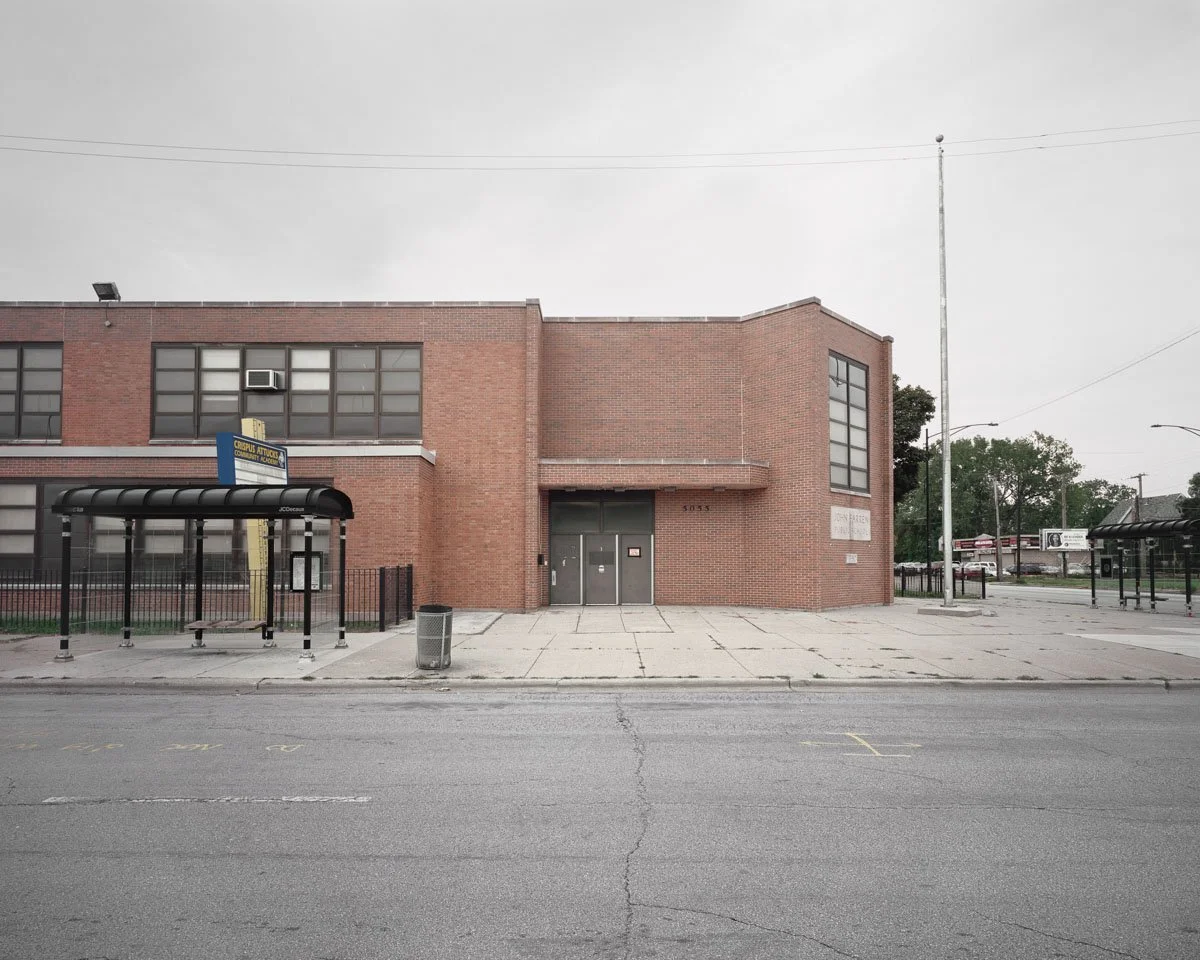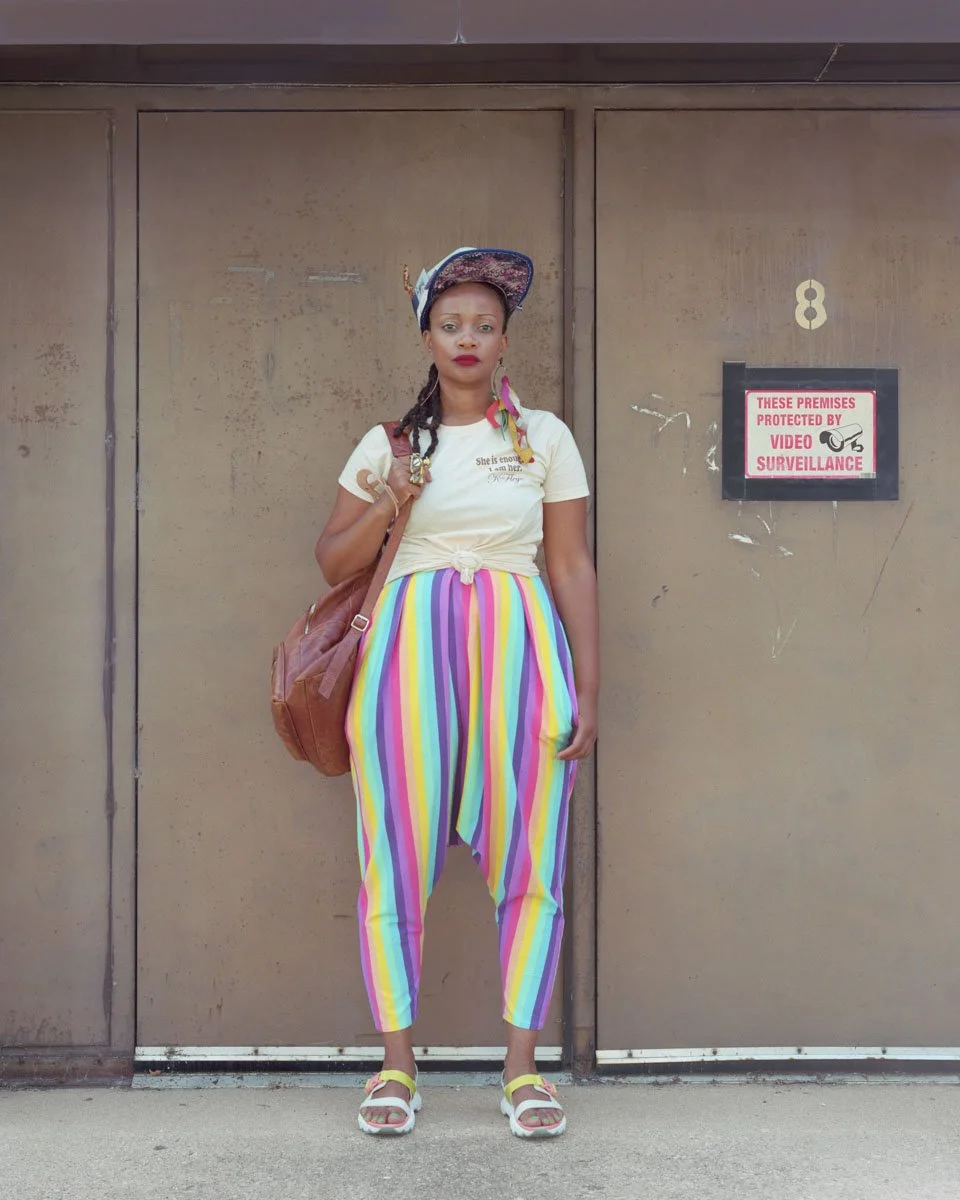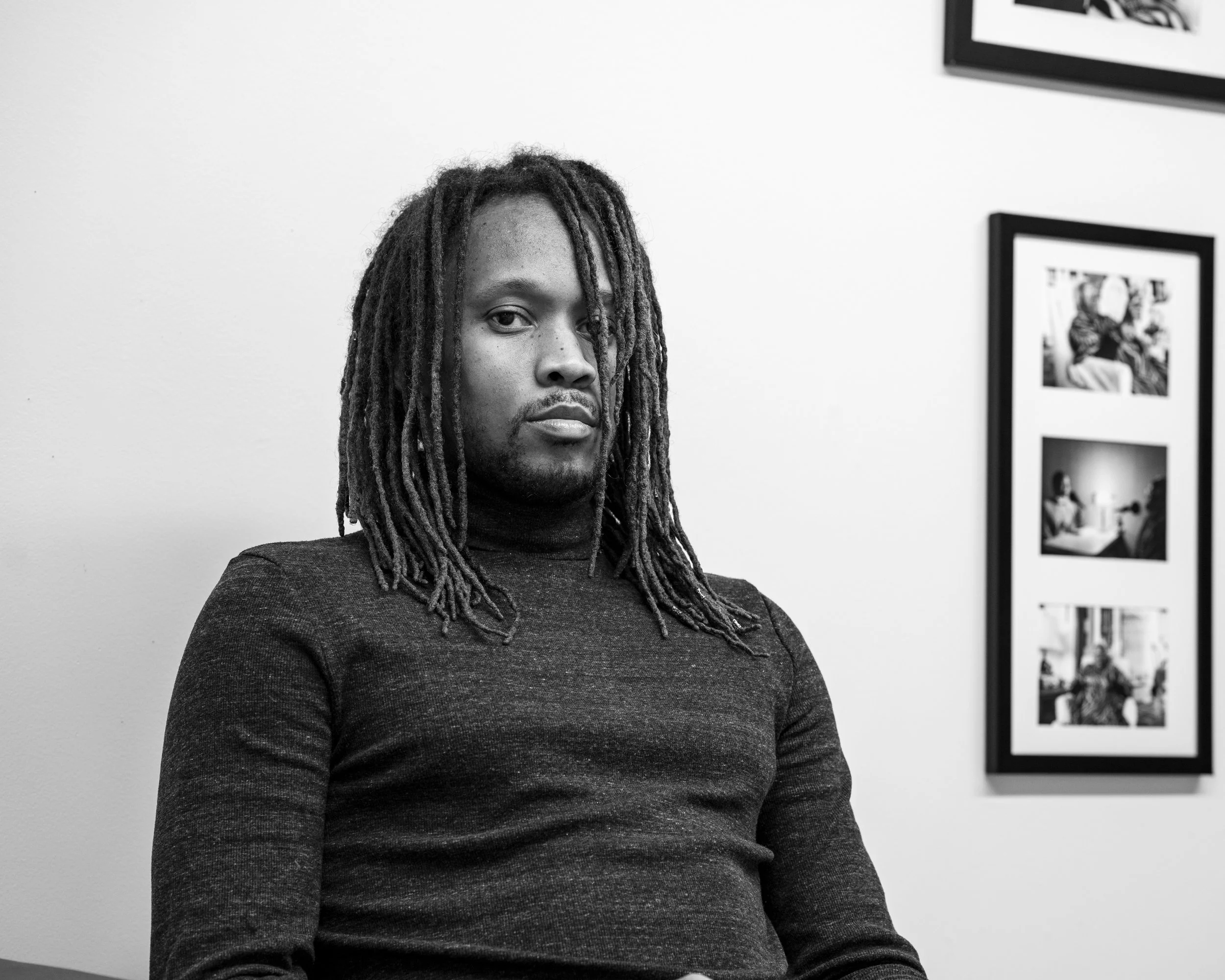Austin Pope
Betsy Ross Elementary, 2018. Inkjet print. 18 x 24 inches
BIO
Upon graduating High School, Austin Pope enlisted in the military as a United States Army Ranger in January 2001. After being deployed to both in Afghanistan and Iraq, he returned to Chicago at the end of his military term in 2005. One thing that became immediately apparent when he became a civilian was the contrast in systemic hierarchies as it related to his experience being a black veteran. The Army provided him with a systemic hierarchy that empowered him as a solider, leaving him with a sense of honor and appreciation. But his experience as a veteran is in direct contrast to the systemic hierarchy he engages in daily in the form of racial oppression. Austin’s fondness for the local art scene emerged in 2013 and soon after, he found a passion for photography. Austin enrolled in the MFA program at School of the Arts Institute in 2018. While attending SAIC, Austin began to explore his relationship between social hierarchies and how they relate to his experiences. Austin currently resides in Chicago IL, where he continues to search for examples of how people of color are influence by the hierarchies they find themselves in, and how they create their counter hierarchies as a form of resistance. Austin’s identity as a black man is juxtaposed to his identity as a veteran; and it is this juxtaposition that serves as the thesis for his work.
ARTIST STATEMENT
The (Mis)Education of Chicago focuses on the Chicago School Closing of 2013; which were primarily executed in black and brown neighborhoods. In 2016 I began revisiting the schools- most of which are abandoned- and documenting them in their current state. In addition to photographing the schools, I began to photograph those impacted by the school closings either directly or indirectly (i.e, they attended, worked at or had a family member that attended the school). The project focuses on one question: what does it mean to have mass closings of learning institutions in black and brown communities and what are the lasting impacts of that decision? Political policy is often the precursor to social disparity; especially as it relates to communities of color. This project intends to explore the harm caused by those policies and how black and brown communities are expected to recover.
Interview with Austin Pope
Betsy Ross Elementary, 2019. Inkjet print. 18 x 24 inches
Can you tell us a bit about your background and how you became interested in becoming an artist?
Upon graduating High School, I enlisted in the military as a United States Army Ranger. After being deployed to both in Afghanistan and Iraq, I returned to Chicago at the end of my military term in 2005. My fondness for Chicago’s local art scene emerged in 2013 when I discovered artists run open mics and performance spaces. Soon after, I found a passion for photography. I decided to enroll in the MFA program at School of the Arts Institute in 2018. While attending SAIC, I began to explore my relationship to systemic social hierarchies and how they impact my experiences as both a veteran and an African American. I’ve recently relocated to Los Angeles in the hopes of expanding my practice.
Can you tell us about some of your most memorable early influences?
Latoya Ruby Frazier and Dawoud Bey come to mind; but my earliest artistic influence was my cousin, Tamasha Williamson. She introduced me to art by teaching me how to draw comic book characters. I wasn’t very good at it, but she would always take the time to help me perfect the craft. She passed away in 2016; before she had the opportunity to pursue her dream of enrolling in an MFA program. She was incredibly talented; well versed in drawing, painting, and singing. Pursuing my MFA in photography is one of the ways I try to honor her. She passed before she had an opportunity to see any of my work. But I know that she can see me now, guiding me on my path as an artist. I’m truly grateful for her presence.
Crispus Attucks Elementary, 2019. Inkjet print. 18 x 24 inches
Where are you currently based and what brought you there? Are there any aspects of this specific location or community that have inspired your work?
I’m currently located in Chicago with plans to move to Los Angeles early next year. One of my latest projects, The (Mis)education of Chicago is based on the Chicago School districts and the closing of almost 50 public schools in 2013. These schools were predominantly located in black and brown neighborhoods. My work attempts to shine a light on the void left by these vacant institutions and their impact on communities of color.
What is your studio space like? What makes your space unique to you?
Most of my photography is done outdoors or in event spaces, so my actual studio is the spare office in my apartment. I prefer this to an off-site studio because it allows me to edit and print at my leisure and in the comfort of my own home.
What is a typical day like? If you don't have a typical day, what is an ideal day? Do you work in large chunks of time, or throughout the day?
My typical day includes working my day job for the federal government. I work on photo projects after working hours. Since my job is low stress and I’m allowed to telework, I have a surprising amount of energy that I dedicate to creating new art projects. I usually come up with an idea, attempt to research any other artist that my new work could potentially be in conversation with, and start to think about how I want to execute the project. It comes in spurts. I think it’s important to create when you’re in the right mindset as opposed to creating on a scheduled/routine basis. If I go several months without taking a photograph, I’m fine with it. But when I’m in the right creative space, I’m more than willing to dedicate my free time to bringing a project to life.
What gets you in a creative groove or flow? Is there anything that interrupts your creative energy?
I don’t know if I have a flow per say. It’s more like I’m prompted by current events or things that I think are important but not often talked about. Even if I have an idea, I won’t act on it right away. I sit with it; seeing how I feel about it over the course of weeks or months at a time. Once I’m committed to the idea, I start to execute it by doing research, visualizing how I hope the project will turn out and allowing for changes to occur as the need arises.
Elle; Burnham Elementary, 2023. Inkjet print. 24 x 18 inches
How do you maintain momentum in your practice? Is there anything that hinders or helps your focus?
I maintain momentum by not adhering to a specific timeline. This is where having a day job becomes crucial for me. If I’m only partially reliant on using my art to create income, I can focus on creating the things that I want to create as opposed to creating projects in the hope of selling it to meet my financial obligations. I find that when I’m patient with myself I’m more thoughtful in my artistic approach.
What medium/media are you working in right now? What draws you to this particular material or method?
I’m primarily working in photography; specifically large format film photography. Photographing using large format is a process in itself; one that can be quite costly and requires a great deal of patience. I love how large format forces me to slow down and consider what I’m photographing before I photograph it. There have been times where I’ve spent over 30 minutes setting up the camera only to determine that this isn’t the photo I want to take. If it isn’t right, it isn’t right. I love that about the process.
Can you walk us through your overall process in making your current work? Does drawing play a role in your process?
My overall approach to any project is to conceptualize, research, plan out how I’d like to present it, execute that plan, and allow whatever creative changes make sense.
What is exciting about your process currently?
I think the depth of my current project is what I’m most excited about. I’ve photographed over forty schools and I plan to paring each school with a portrait of a person impacted by the school’s closing. It’s labor intensive and totally dependent on community response. But I think it’s worth it.
Can you talk about some of the ongoing interests, imagery, and concepts that have informed your process and body of work over time? How do you anticipate your work progressing in the future?
One of the subjects I’m really interested in is mental health as it relates to veterans. I’m also interested in the ways that systemic racism impacts African Americans and the counter systems we create in response as a mode of survival. I’m not an expert in photography by any means. As I progress in my practice, I’m hoping that my artistic style will begin to manifest itself. I’d also like to work on smaller projects that use different mediums in addition to photography.
KFlye; Crispus Attucks Elementary, 2023. Inkjet print. 24 x 18 inches
Do you pursue any collaborations, projects, or careers in addition to your studio practice? If so, can you tell us more about those projects, and are there connections between your studio practice and these endeavors?
My career at the VA intersects with some of the projects I hope to create in the future. Being a veteran and seeing the amount of resources that the VA pours into veteran mental health allows me to have a unique understanding on the matter. I’m hoping that it will manifest into a project one day.
Have you had any epiphanies recently that have changed the course of your work or caused you to shift directions?
My biggest epiphany is that making art can be very discouraging at times. This is especially true when you’re hoping to receive an opportunity to show your work at an art space or institution only for them to say no. When that happens, I have to remind myself why I pursued art in the first place. Your work matters. Your narratives matter. I have to remind myself that I can’t compare my progression as an artist to my counterparts. Rather, I must stay committed to my own path.
Can you share some of your recent influences? Are there specific works—from visual art, literature, film, or music — that are important to you?
Dawoud Bey’s Birmingham Project and Night Come Tenderly come to mind. What stands out the most about these two works is the way he uses context to emphasize the importance of the photos. The portraits are just portraits until he explains why he took them and their direct historical ties. Then the photos take on a whole new meaning. This is something that I’ve tried to emulate in The (Mis)education of Chicago. The buildings are just buildings until you realize that each of them represents closed schools formerly serving students of color. Then the photos take on a whole new meaning.
Solomon; Betsy Ross Elementary, 2023. Inkjet print. 24 x 36 inches
Can you elaborate on a recent work of yours, and tell us the story of how it came to be?
My most recent work, The (Mis)Education of Chicago focuses on the Chicago School Closing of 2013. Former Mayor Rahm Emmanuel, along with Chicago Public Schools (CPS) closed over 40 schools on the North, South and West sides of Chicago. CPS claimed that these institutions were underutilized, underperforming, and no longer serving the local communities. However, this abrupt departure left an educational gap in Black and Brown communities. In 2016 I began revisiting the schools- most of which are abandoned- and documenting them in their current state. Partially influenced by Hilla and Brend Becher, I use a large format view camera to document the building, focusing on the entryway for each school. In addition to photographing the schools themselves, I began using both digital and large format film cameras to capture residents of the local communities impacted by the school closings in front of the buildings themselves. I then began taking portraits to pair with the photos of the buildings. The portraits consist of anyone negatively impacted by the school closures: whether they were employed by, attended, lived near or had family members that attended these institutions. Because those impacted by the closures weren’t properly considered when the city planned a way forward, documenting them became essential. Each portrait was paired with a portrait of a closed school based on the person’s connection to the school. Both the photos of the schools themselves and the people impacted by the closings serve as a testament to the aftermath caused by systemic racism. It highlights the fact that people of color are not responsible for the social economic systems we find ourselves in; we simply learn to survive in them. Little consideration was given to the families that attended these schools, as some of them now cross gang lines to get to their new institution. Some schools were repurposed as specialty schools serving mostly white communities. Some were converted into high end lofts. But most remain boarded up and abandoned, leaving a void in the local commonwealth.
Have you overcome any memorable roadblocks or struggles in your practice that you could share with us?
Not that I can think of.
Who are some contemporary artists you’re excited about? Is there a recent exhibition that stood out to you?
I recently attended an exhibition at Swivel Gallery in New York called Botany of Desire, curated by Sadaf Padder. I was really impressed with the curation of the show and the artists that participated in it. I left feeling inspired.
Do you have any tips or advice that someone has shared with you that you have found particularly helpful?
Keep creating no matter what!
What are you working on in the studio right now? What’s coming up next for you?
Right now I’m working on the portrait series for The (Mis)Education of Chicago. I’m in the process of identifying individuals that were affiliated with one of the closed schools. I’m a little nervous since it’s such a huge undertaking; especially photographing in large format. But I honestly feel that photographing the schools without at least attempting to photograph the communities that were impacted by the school closings would be a disservice. Even though I’m nervous, I’m excited about the project.
Anything else you would like to share?
Yes! [Contact Pope for] the QR code to my project. If you were affiliated with one of the closed schools in Chicago I’d love to photograph you!
Austin Pope
To find out more about Austin Pope check out his website and Instagram.







